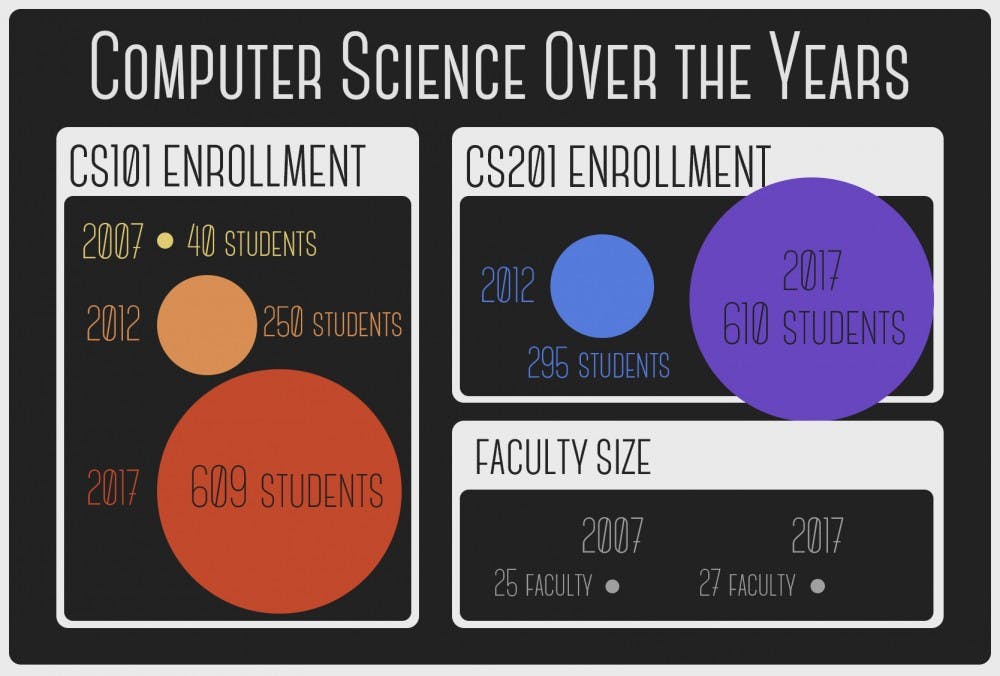Duke's computer science major has grown to be one of its largest programs, confirmed Owen Astrachan, associate director of undergraduate studies and professor of the practice of computer science.
“People outside of Duke think it's a place where [students] major in public policy and economics. That’s kind of the word on the street," he said. "Wouldn’t it be great if people come to Duke thinking it’s the place where people do policy, economics, computer science and the interplay between them?"
Within the last five years, annual enrollment in Computer Science 101L has grown from 250 to 609 students, noted Susan Rodger, director of undergraduate studies and professor of the practice of computer science. Going back further, only about 40 students each enrolled in Fall and Spring 2007. Likewise, the number of students registered for Computer Science 201 increased from 295 students five years ago to 610 students in 2017.
In May, Astrachan said he compared enrollment and retention numbers by contacting other major departments at Duke, as well as the Office of the University Registrar. He found that the economics, public policy and computer science majors were the most popular for the Class of 2017. However, designating a single major as "the biggest" wasn't feasible due to how each department reports the number of graduates.
"The differences between the departments in terms of numbers are too small to measure accurately since some students might not graduate depending on final exams, for example," he wrote in an email.
Former students described several reasons for joining the computer science department, including career prospects and an interest in the field's broader applications.
“Since tech has gained so much popularity, it's almost become sort of a default for people that don't know what they actually want to do,” said Kevin He, Trinity '17.
Jeremy Fox, Trinity '17, echoed the sentiment, describing the class size growth as “a pretty rational response to a growing tech industry.” Fox, who began as a Pratt student, later realized he "could do more with computer science—data science, software, relating computer science to policy.”
Computer science has numerous applications in other fields—such as economics, physics, statistics, biology—and many students who take a few courses ultimately decide to complete the major or minor, Astrachan said.
“A lot of my friends from high school who were originally studying economics or math are all now interested in computer science,” He said.
Despite the growth in demand, the size of Duke’s computer science faculty has not kept up. Astrachan noted that in May, 27 professors were members of the department, marking a slight increase from 25 professors in 2007.
“It’s concerning [that] we are [one of the] most popular [majors] and we’re by far the smallest of departments [with similar interest] in terms of faculty," Astrachan said. "You have to be careful because one person could say ‘Well gee, if you could do it with so few, then I guess we can give you even fewer.’
It’s not just faculty that have been spread thin—the department faces a "dilemma" due to a shortage of teaching assistants, said Ellen Yuan, Trinity '17, who was a CS 101L teaching assistant for six semesters.
Despite limited departmental resources, the recent graduates said they gained a lot from the department’s offerings.
For example, He credited Computer Science 308, Software Design and Implementation, for its “very valuable lessons on how to communicate and do group work effectively,” noting that this was just as important as programming ability in the tech industry.
Classes listed as 500-level are typically geared towards graduate students, but Fox said he wished undergraduates would be more aware of the 500-level computer science courses.
Yuan cited teaching the lab component of CS 101—which featured small group sessions with 20 students—as part of her inspiration to eventually teach computer science in the K-12 environment.
“You don’t know about CS until you get into college,” she said.
Asked what additional resources might mean for the department and its growing number of interested students, Astrachan said, “It’d make a good major even better."
At the same time, Astrachan warned about the potential consequences of Duke not providing the department with more resources.
“We have a lot of world-class faculty,” he said. “At some point, they’re going to say ‘Why am I staying here if I could go to all of the other schools Duke compares itself to, and they’re going to be providing many more resources?’”
Editor's Note: The Chronicle spoke with Astrachan both over the phone and via email.
Correction: This article has been updated to reflect that the number of students in CS 201 increased from 295 students five years ago to 610 students in 2017, not 610 students in Spring 2017. The Chronicle regrets the error.
Get The Chronicle straight to your inbox
Signup for our weekly newsletter. Cancel at any time.

